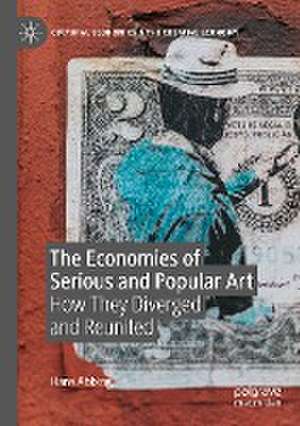The Economies of Serious and Popular Art: How They Diverged and Reunited: Cultural Economics & the Creative Economy
Autor Hans Abbingen Limba Engleză Paperback – 30 noi 2023
| Toate formatele și edițiile | Preț | Express |
|---|---|---|
| Paperback (1) | 727.18 lei 6-8 săpt. | |
| Springer Nature Switzerland – 30 noi 2023 | 727.18 lei 6-8 săpt. | |
| Hardback (1) | 732.40 lei 6-8 săpt. | |
| Springer Nature Switzerland – 29 noi 2022 | 732.40 lei 6-8 săpt. |
Preț: 727.18 lei
Preț vechi: 886.80 lei
-18% Nou
Puncte Express: 1091
Preț estimativ în valută:
139.16€ • 143.76$ • 115.82£
139.16€ • 143.76$ • 115.82£
Carte tipărită la comandă
Livrare economică 26 martie-09 aprilie
Preluare comenzi: 021 569.72.76
Specificații
ISBN-13: 9783031186509
ISBN-10: 3031186508
Pagini: 345
Ilustrații: XIII, 345 p. 1 illus.
Dimensiuni: 148 x 210 mm
Greutate: 0.43 kg
Ediția:1st ed. 2022
Editura: Springer Nature Switzerland
Colecția Palgrave Macmillan
Seria Cultural Economics & the Creative Economy
Locul publicării:Cham, Switzerland
ISBN-10: 3031186508
Pagini: 345
Ilustrații: XIII, 345 p. 1 illus.
Dimensiuni: 148 x 210 mm
Greutate: 0.43 kg
Ediția:1st ed. 2022
Editura: Springer Nature Switzerland
Colecția Palgrave Macmillan
Seria Cultural Economics & the Creative Economy
Locul publicării:Cham, Switzerland
Cuprins
Chapter 1: Preface.- Chapter 2: The Triumph of Serious Art.- Chapter 3: Authentic Art and Artists.- Chapter 4: Exclusion.- Chapter 5: Distrust of Commerce and Commercialism.- Chapter 6: Sharing Art.- Chapter 7: Present and Future Changes.- Chapter 8: Conclusion.
Recenzii
“The Economies of Serious and Popular Art is accessible to diverse readers. … Well-researched and drawing most notably from the disciplines of sociology and economics, Abbing also inserts many examples throughout the 345-page text to illustrate the applications of the phenomena his book explores. These examples work well … .” (Bronwyn Coate and Ellen Loots, Journal of Cultural Economics, Vol. 47 (4), 2023)
Notă biografică
Hans Abbing is a visual artist and economist. He is also Emeritus Professor in Art Sociology at the University of Amsterdam, the Netherlands, and teaches MA Cultural Economics and Cultural Entrepreneurship at the Erasmus University of Rotterdam, the Netherlands. He previously published The Changing Social Economy of Art and Why Are Artists Poor?
Textul de pe ultima copertă
Combining an economic perspective with sociological and historic insights, this book investigates the separation of ‘popular’ and ‘serious’ art over a period of almost two centuries. As the boundaries between our perceptions of established art and popular become more porous, Abbing considers questions such as: Who benefitted from the separation? Why is exclusivity in the established arts so important? Did exclusivity lead to high cost, high subsidies and high prices? Were and are underprivileged groups excluded from art consumption and production? How did popular music become so successful in the second half of the twentieth century? Why does the art profession remain extraordinarily attractive for youngsters in spite of low incomes? The book also discusses the evolution of art in the twenty-first century, considering for example how the platform economy affects the arts, whether or not the established arts are joining the entertainment industry, and the current level of diversity in art. Written from the dual perspective of the author as an artist and social scientist, the book will be of interest for cultural economists and academics as well as artists and general readers interested in art.
Hans Abbing is a visual artist and economist. He is also Emeritus Professor in Art Sociology at the University of Amsterdam, the Netherlands, and teaches MA Cultural Economics and Cultural Entrepreneurship at the Erasmus University of Rotterdam, the Netherlands. He previously published The Changing Social Economy of Art and Why Are Artists Poor?
Caracteristici
Combines a cultural economic perspective with sociological and historic insights Discusses the evolution of art over a period of two centuries Draws on the author's experience as an economist and a visual artist



